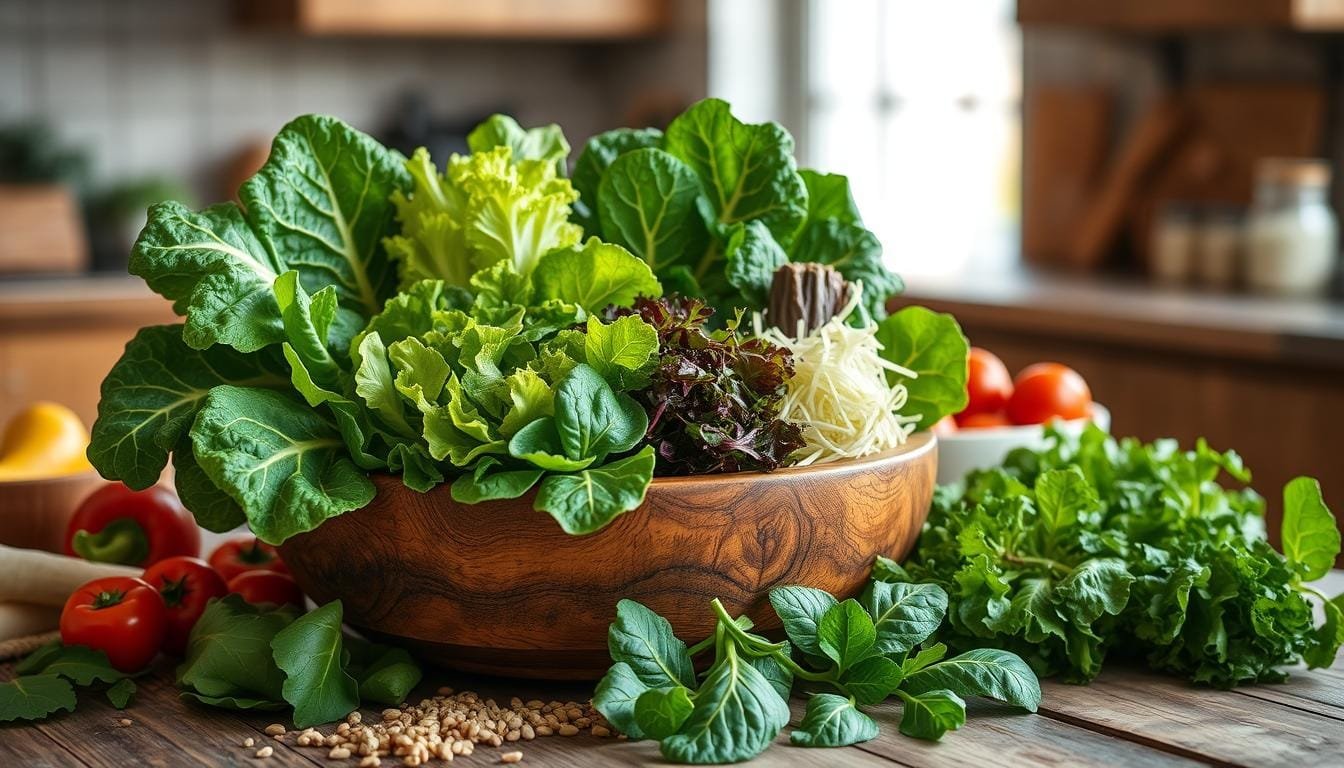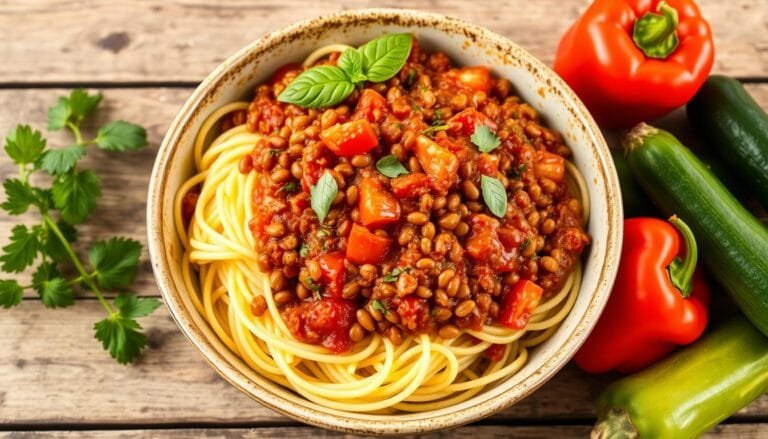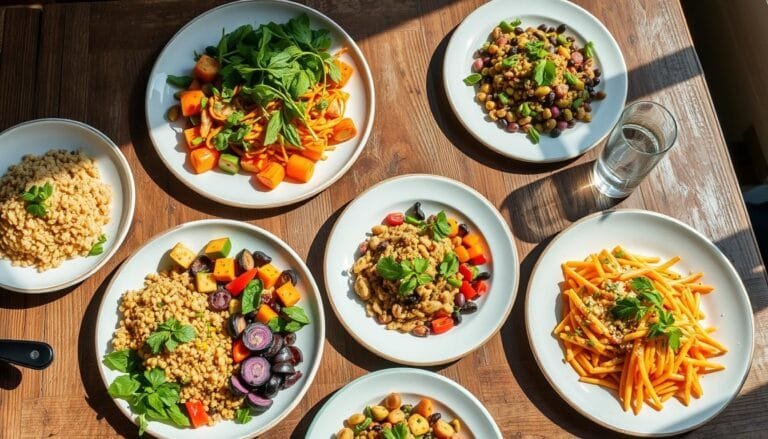As a vegan, adding leafy greens to my meals is key. These greens are packed with vitamins, minerals, and antioxidants. They are vital for a plant-based diet. Kale, spinach, romaine, and arugula are just a few examples. They bring color, flavor, and health benefits to my vegan life.
In this guide, I’ll talk about why leafy greens are important for vegans. I’ll also share the most nutritious options and how to add them to my meals. Whether it’s in smoothies, stir-fries, wraps, or bowls, I’m excited to see how they can improve my vegan cooking and health.
Why Leafy Greens Are Essential for Vegan Nutrition
As a vegan, it’s key to eat leafy greens for good health. These greens are full of micronutrients, antioxidants, and fiber. They help keep you healthy in many ways.
Key Nutrients in Leafy Greens
Kale, spinach, and other greens are packed with vitamins and minerals. They have Vitamins A, C, and K, folate, and more. These nutrients boost your immune system, skin, and bones.
They also have iron and calcium. These are important for healthy blood and strong bones.
Health Benefits for Vegans
Eating leafy greens is good for vegans. The fiber in them helps your gut and blood sugar. It also fights inflammation.
The antioxidants in these greens fight cell damage. They help you age well and lower disease risks like heart disease and cancer.
Role in Plant-Based Protein Synthesis
Leafy greens are important for making plant-based proteins. The chlorophyll in them helps detoxify your body. This makes your body use plant proteins better, helping muscles recover and giving you energy.
Adding different leafy greens to your diet is a smart move. It brings you many nutrients and helps you stay healthy and full of energy.
“Leafy greens are the foundation of a healthy vegan diet, providing an abundance of vital nutrients that support every aspect of our wellbeing.”
Most Nutritious Leafy Greens for Your Vegan Menu
Leafy greens are key for a vegan diet, packed with essential nutrients. From kale to spinach, there’s a lot to explore. These greens can make your vegan meals both healthy and tasty.
Collard greens stand out for their nutrients. They’re full of vitamins A, C, and K, plus folate and calcium. You can sauté, steam, or use them as wraps for a nutritious vegan meal.
Arugula is another must-have, known for its peppery flavor. It’s loaded with antioxidants, vitamins, and minerals. Great for salads, sandwiches, and pesto.
Swiss chard is also a powerhouse. It’s packed with vitamins, minerals, and phytonutrients. Add it to sautés, soups, or stews for a nutritional boost.
Watercress is a nutrient-dense green you should try. It’s full of vitamins, minerals, and antioxidants. Enjoy it raw in salads, in smoothies, or lightly sautéed.
Adding a variety of leafy greens to your vegan diet is key. They provide essential nutrients, support health, and add flavor to your meals.
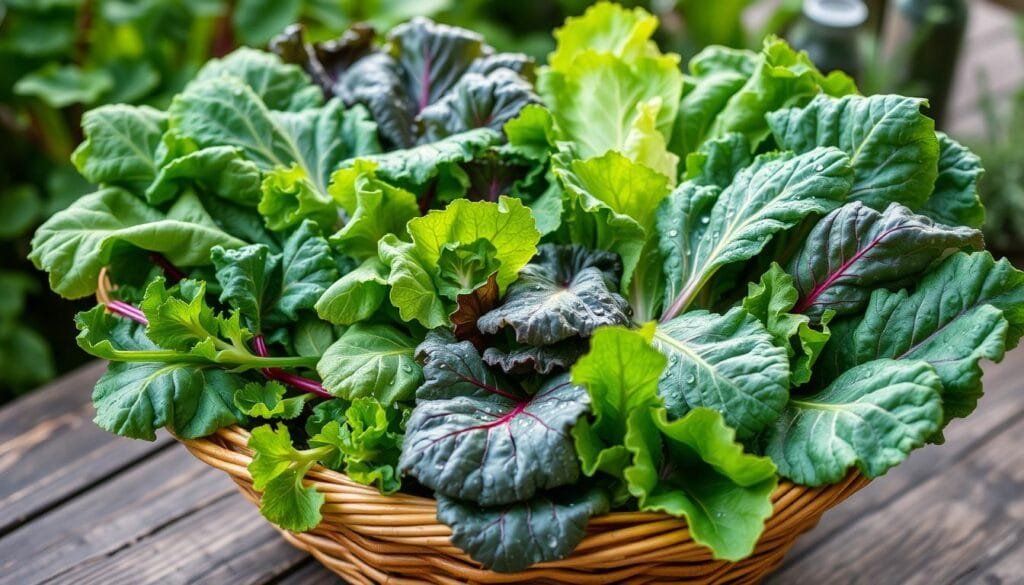
“Leafy greens are the foundation of a healthy, balanced vegan diet. They offer an abundance of vitamins, minerals, and phytonutrients that are vital for well-being.” – Nutritionist Sarah Johnson
Incorporating Leafy Greens in a Vegan Diet
Adding leafy greens to your vegan diet is key for good health and nutrition. You can enjoy them in many ways, like in green smoothies, salads, stir-fries, and soups. They are packed with nutrients and can be a great addition to your meals.
Morning Green Routines
Begin your day with a green smoothie. Blend spinach, kale, or Swiss chard with fruits and plant-based milk or nut butter. This mix gives you a healthy start with lots of nutrients.
Lunch and Dinner Integration
At lunch, add leafy greens to your meals. Try them in salads, collard green wraps, or stir-fries. Use different greens like arugula and beet greens to keep things interesting.
Smart Snacking with Greens
- Make crunchy kale chips for a healthy snack.
- Blend greens into homemade hummus or dips for extra nutrition.
- Use lettuce cups for tasty, plant-based snacks.
By eating leafy greens all day, you’ll meet the daily veggie goal. Try new recipes and flavors to enjoy these greens more.
Creative Ways to Blend Greens into Smoothies
Adding leafy greens to your diet can change your life. Blending them into green smoothie recipes is a tasty way to get more nutrients. You can make everything from energizing breakfast smoothies to refreshing midday drinks.
Start by trying different greens like spinach, kale, or Swiss chard. These greens are full of vitamins, minerals, and antioxidants. Mix them with fruits like bananas, berries, or citrus for a sweet and creamy breakfast smoothie that boosts your energy.
Feel free to mix things up in your smoothies. Avocado makes them creamy, while beets and escarole add color and flavor. Adding superfoods like chia seeds, goji berries, or spirulina can give you an extra health boost. The fun of making green smoothies is endless.
| Ingredient | Benefits |
|---|---|
| Kale | More absorbable calcium and iron than spinach and Swiss chard |
| Overripe Bananas | Freeze and use later in smoothies for creaminess |
| Avocado | Adds a creamy consistency to smoothies |
| Beets, Escarole, Red Leaf Lettuce | Can be experimented with in smoothies |
| Citrus Fruits | Alkalizing for the body and add flavor to smoothies |
| Blueberries, Blackberries, Açai Pulp | Help mask the green color in smoothies |
| Cucumber | Adds freshness to smoothies |
Start with small amounts of greens in your smoothies and add more as you get used to the taste. With a good blender, you can make tasty and nutrient-dense drinks that make you feel great.
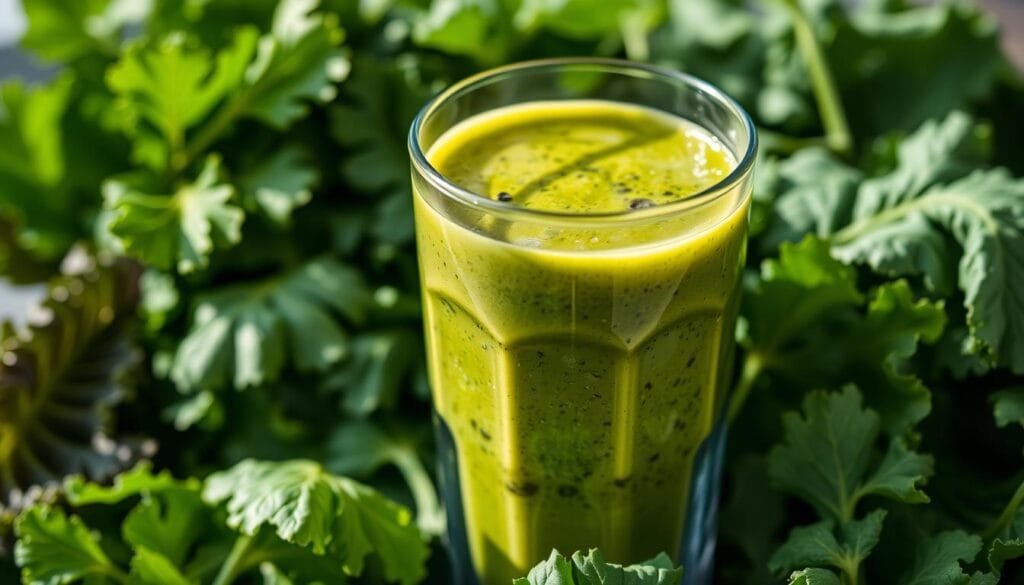
Cooking Techniques for Delicious Leafy Greens
Adding leafy greens to a vegan diet boosts nutrition and flavor. Learning different cooking methods is key to enjoying these veggies fully. Let’s dive into the art of cooking tasty leafy greens.
Steaming and Sautéing Methods
Steaming is a fast way to keep leafy greens’ nutrients. It makes the leaves tender without losing their color and taste. Sautéing adds richness to greens. Cooking them in a pan with a bit of oil makes them sweet and tender.
Baking and Roasting Tips
Baking or roasting gives leafy greens a crispy twist. Kale and collard greens become irresistible chips or caramelized bites. This method enhances flavors and adds a satisfying crunch.
Raw Preparation Techniques
Raw leafy greens are also great. Spinach, arugula, and baby kale are perfect for salads, wraps, and bowls. A simple dressing brings out their natural flavors and textures.
Try different cooking methods to find what works best for you and your greens. Mastering leafy green cooking lets you add them to your vegan meals easily. This way, you create tasty, healthy dishes that make you feel good.
“Leafy greens are truly the superstars of the plant-based world, providing unmatched nutrition and versatility for endless enjoyment.”
Making Flavorful Green Sauces and Dips
As a vegan, it’s key to add leafy greens to your diet. But why stick to plain salads? You can make tasty green sauces and dips instead. These not only add flavor but also boost nutrition.
One favorite of mine is vegan pesto. Mix basil, parsley, or spinach with olive oil, nuts, and spices. This makes a creamy sauce that’s great on pasta, sandwiches, and veggies. Plus, you can adjust the flavors to your taste.
Green goddess dressing is another hit. It’s made with avocado, yogurt, and herbs like parsley and basil. It’s perfect for dipping veggies, as a salad dressing, or a topping.
Chimichurri adds a zesty touch. It’s a mix of parsley, garlic, olive oil, and vinegar. It’s great with grilled veggies, tofu, or vegan burgers.
These green sauces and dips are super versatile. They can make any meal more flavorful and nutritious. Try mixing different greens, nuts, and spices to create your own unique sauces.
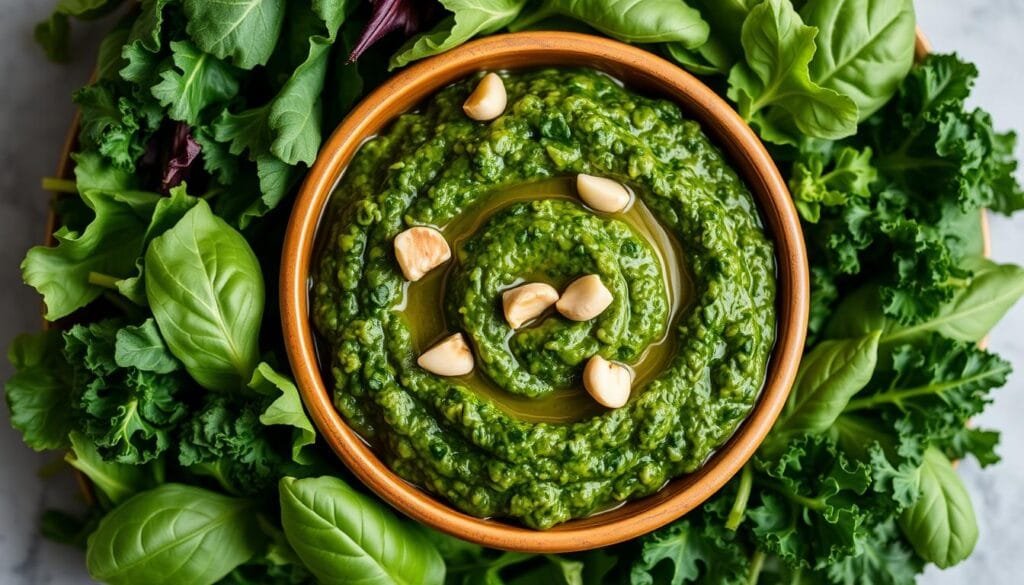
| Sauce/Dip | Key Ingredients | Serving Suggestions | Nutrition (per 2 tbsp) |
|---|---|---|---|
| Vegan Green Goddess Dip | Avocado, yogurt, parsley, cilantro, basil, dill, lemon, garlic, green onions, salt | Vegetables, salads, sandwiches, roasted veggies | 41 calories, 3g carbs, 1g protein, 3g fat, 152mg sodium, 2g fiber |
| 5 Minute Magic Green Sauce | Avocado, parsley, cilantro, jalapeño, garlic, lime, water, olive oil, salt, pistachios | Pasta, sandwiches, roasted vegetables | Not available |
Make the most of your vegan diet with these green sauces and dips. Your taste buds and body will love it!
Using Leafy Greens as Wraps and Bases
As a vegan, you can use leafy greens in more ways than salads. These greens are packed with nutrients and can replace traditional wraps and bases. They offer low-carb, grain-free options for many meals.
Collard Green Wrap Ideas
Collard green leaves are great for wraps. They’re big and flexible, perfect for filling with vegan proteins, roasted veggies, and more. Each wrap has 11g of protein and 10g of fiber, making them very nutritious.
Lettuce Cup Variations
Crisp lettuce leaves, like romaine or butter lettuce, can become light, refreshing lettuce cups. Fill them with vegan ingredients, such as low-carb wraps, fresh herbs, and a tasty sauce. It’s a healthy, healthy tacos-inspired meal.
Bowl Base Options
Use mixed greens or chopped kale as a base for a nutrient-dense bowl. These grain-free options are strong and let you add roasted veggies, plant-based proteins, and toppings.
Using leafy greens in these ways lets you enjoy many satisfying, low-carb, and nutritious meals. They fit well with a vegan lifestyle.
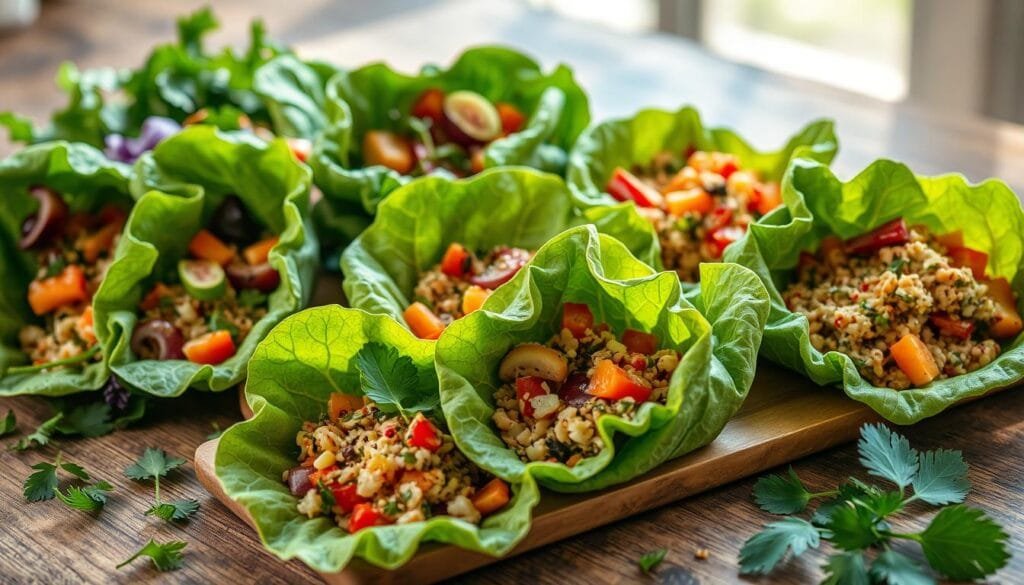
Seasonal Guide to Leafy Green Selection
As a vegan, picking the right leafy greens is key. Choosing them based on the season ensures freshness, flavor, and nutrition. This way, your meals are always top-notch.
In spring, spinach and arugula are at their best. They add a light, peppery taste to salads and sandwiches. Summer brings kale and Swiss chard, perfect for heartier dishes.
Fall and winter bring collards and Brussels sprouts to the table. Their strong flavors and textures match the season’s richer foods. Check your local farmers market or guide to find the best seasonal greens.
| Season | Recommended Leafy Greens |
|---|---|
| Spring | Spinach, Arugula, Watercress, Romaine Lettuce |
| Summer | Kale, Swiss Chard, Rainbow Chard, Mustard Greens |
| Fall | Collards, Turnip Greens, Endive, Broccoli Rabe |
| Winter | Bok Choy, Brussels Sprouts, Cabbage, Romaine Lettuce |
Choosing leafy greens with the seasons boosts their freshness and taste. It also supports local farmers and markets. It’s good for you and the planet!
Storage Tips for Maximum Freshness and Nutrition
Storing your leafy greens right is key to keeping them fresh and nutritious. Here are some tips to help you store your produce well. This way, you can keep food fresh and cut down on waste:
- Wash and dry your greens well before storing. Excess moisture can cause them to spoil, so make sure to get rid of it.
- Put the greens in airtight containers or resealable bags. Adding a paper towel can help soak up any leftover moisture.
- Store the greens in the fridge’s crisper drawer. This area has the best temperature and humidity for keeping them fresh.
- For longer storage, consider blanching and freezing your greens. This method keeps their nutrients and flavor locked in.
By following these simple tips, you can enjoy your leafy greens at their best. Proper storage not only keeps your veggies fresh. It also helps reduce waste, saving you time and money.
| Produce | Ideal Storage Conditions | Shelf Life |
|---|---|---|
| Leafy Greens (Kale, Spinach, Arugula) | Refrigerator, in airtight container or bag with paper towel | 3-5 days |
| Broccoli | Refrigerator, in airtight container or bag | 3-5 days |
| Carrots | Refrigerator, in airtight container or bag with paper towel | 2-3 weeks |
| Tomatoes | Room temperature, out of direct sunlight | 3-5 days |
Choosing fresh, high-quality produce is the first step to keeping it fresh and nutritious. By following these storage tips, you can keep your leafy greens and other plant-based foods fresh. This reduces waste and lets you enjoy the full benefits of a vegan diet.
“Proper storage is essential for preserving the freshness and nutritional value of our produce. By taking a few simple steps, we can reduce food waste and enjoy the full benefits of a plant-based diet.”
Common Mistakes to Avoid When Preparing Leafy Greens
As a vegan, it’s key to make the most of your leafy greens. Avoid overcooking them to prevent nutrient loss and a soggy texture. Instead, use gentle steaming or quick sautéing to keep their colors and health benefits.
Don’t use too much oil or heavy dressings on your greens. While fats are good, too much can ruin their health benefits. Choose light vinaigrettes or dips to add flavor without losing nutrients.
Food safety is critical with leafy greens. Make sure to wash them well to remove contaminants. Try different greens to get a variety of nutrients and follow cooking tips for a balanced vegan diet.
